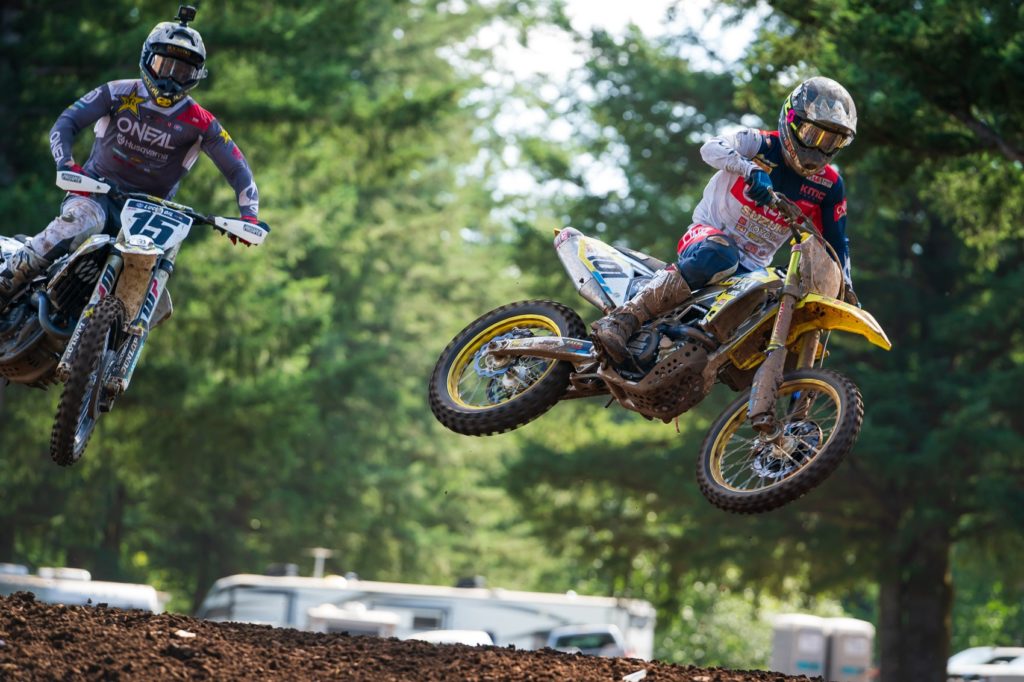MX Sports | New Rules On Anti-Doping & 450 Class Eligibility
Share

INSTAGRAM | @promotocross
www.promotocross.com
MX Sports Pro Racing has released the full competition rulebook for the 2020 Lucas Oil Pro Motocross Championship. It’s common to see clarification or amendments to the official guidelines of the series each season, like the addition of alternates for motos in 2018, but this year’s changes to anti-doping punishments, 450 Class eligibility, helmet camera use, and an established code of conduct are significant to the future of the sport.
The 2020 rule book, which can be viewed in full here, is separated into different sections so we will address the changes in the order of perceived importance, starting with requirements to compete in the 450 Class. Starting in 2020 the minimum age of a racer in the 450 Class class will be 18 years old, a two-year increase from the long-time standard of 16 years old. This will encourage (if not to an extent, require) racers to spend time developing their craft in the 250 Class; many privateer racers prefer to race the 450 Class due to the better purse payout.
That change leads to the next eye-opening addition: starting in 2021, riders competing in the 450 class must provide proof of a high school diploma or its equivalent (a GED), or be actively enrolled in a high school graduate program, as determined in the sole discretion of MX Sports Pro Racing. This requirement shall not apply to riders holding an unlapsed AMA Pro Motocross license issued prior to 2020. Completed basic education has never been required in motocross, though the topic was widely discussed after home schooling’s rise in popularity. This will certainly become a matter that future generations of racers, including some current amateur prospects, will have to take care of before they step to the premier division.
The decision by MX Sports to partner with USADA means that the series has to comply with the rules and procedures of the WADA Code. The code’s strict and lengthy multi-year punishments, which are meant to discourage athletes in Olympic-level sports from using performance-enhancing substances, do not meet up with the rapid competition schedule and career timelines of professional motocross. Starting in 2020, riders will not be at risk of a four-year ban in their first breach of the WADA Code. Instead, riders will face a maximum period of ineligibility of one year for violations which involve a Specified Substance and a maximum period of ineligibility of two years for violations which involve a non-Specified Substance or Prohibited Method. Penalties for violations of the MXS AntiDoping Policy other than those for non-Specified and Specified substances or for multiple violations may exceed two years. MXS shall at its sole discretion determine the effective date of the suspension. This is another significant development as it shows some freedom with the anti-doping agencies, but there is zero indication of the series adopting a punishment policy as lenient as those used in the NFL/NBA/MLB.
MX Sports has also clarified the selection criteria for post-race anti-doping tests, as the riders chosen to provide specimens for testing shall include riders finishing or currently ranked in the top three (3) race positions in each of the 450 and 250 classes, plus several riders per class selected at random from the top 20 race finishes, with all registered riders having an equal chance of selection.
Making motocross appear as professional as possible is something that we all agree is a positive step, and for 2020, MX Sports has added a complete Code of Conduct to the rule book. Credentialed riders and representatives must adhere to the code, which includes standard boilerplate of treating others with courtesy (no disparaging remarks about another person’s race, color, creed, national origin, gender, sexual orientation, marital status, religion, age or handicapping condition) and forbids conduct that is offensive, abrasive, in bad taste, or otherwise inappropriate. Acts or omissions that constitute a violation of MX Sports Pro Racing Rules, or are detrimental to motorcycle racing, AMA Pro Motocross, MX Sports Pro Racing, AMA Pro Racing, Promoters, sponsors, participants or fans, may result in the imposition of penalties.
Two more parts that caught our attention pertained to a rider’s actions. Per the rule book, riders may be requested to make appearances at pre-arranged fan and media engagements, which includes autograph sessions, television interviews, fan forums, tech talks, and the like (We have to assume this includes post-race press conferences, which have at times been a chore to get riders to attend in a timely manner, especially if there’s a chance of getting a late flight out of a nearby airport). Failure or refusal to participate as mutually agreed, once scheduled and notified either in-person or through the event schedule, supplementary regulations or otherwise, may result in the imposition of penalties. Arriving late, missing the activity or departing early, without permission from MXS Pro Racing Officials, is a breach of this regulation.
The second part outlined that remarks made by any credential holder that unreasonably or excessively publicly criticizes and/or disparages AMA Pro Motocross, MX Sports Pro Racing, AMA Pro Racing or its Officials may be considered to be acting in an unsportsmanlike manner prejudicial or detrimental to the sport in violation of these rules, and accordingly subject to penalties as outlined in Appendix A.
The use of cameras and distribution of footage from a rider’s perspective has been a hotly contested item at different times in the sport and for 2020, the rules seem to be relaxed. There is no mention of a brand holding exclusive rights to the series, ala GoPro or Garmin, and riders are authorized to use on-board or helmet-mounted video recording device or its likeness during on-track activity under certain guidelines: on-track or race footage for internal engineering, mechanical or rider development purposes is unlimited, while the use of on-track or race footage for public viewing or distribution is limited to the social media platforms of the rider and registered Premier/Feature Teams only. Footage posted on the rider’s social media is restricted to clips no longer than sixty (60) seconds in length each, not to exceed two (2) minutes in the aggregate, per event. All published clips must be tagged with and include the Series social media handles. Cameras and helmets must be approved by MX Sports prior to use, during the pre-event technical inspection.
There are a handful of other rules worthy making note of, like how Race Boots are required and must be standard issue in the industry (work boots are prohibited), jersey material must be standard issue in the industry (polyester), and that costumes, as determined by MX Sports Pro Racing in its sole discretion, are prohibited.
Want to see all the little details for yourself? Click here to read the full rule book for the 2020 Lucas Oil Pro Motocross Championship.

































MX Sports / AMA Pro Racing – Great job addressing education, that was way overdue. However, you are repressing freedom of speech with the following:
“any credential holder that unreasonably or excessively publicly criticizes and/or disparages AMA Pro Motocross, MX Sports Pro Racing, AMA Pro Racing or its Officials may be considered to be acting in an unsportsmanlike manner prejudicial or detrimental to the sport in violation of these rules, and accordingly subject to penalties as outlined in Appendix A. ” This rule is very un-American.
Are you kidding me with the disparage bullshit! Following the leader of the media! Liberal bitches! Oh, I don’t like what that mean person said about me, wah wah sounds like China I wonder if they have a stake inks sports, sounds like they do. Please please expect lawsuits and go will loose them on also, good way to deter people from watching a series that the owners are sellouts